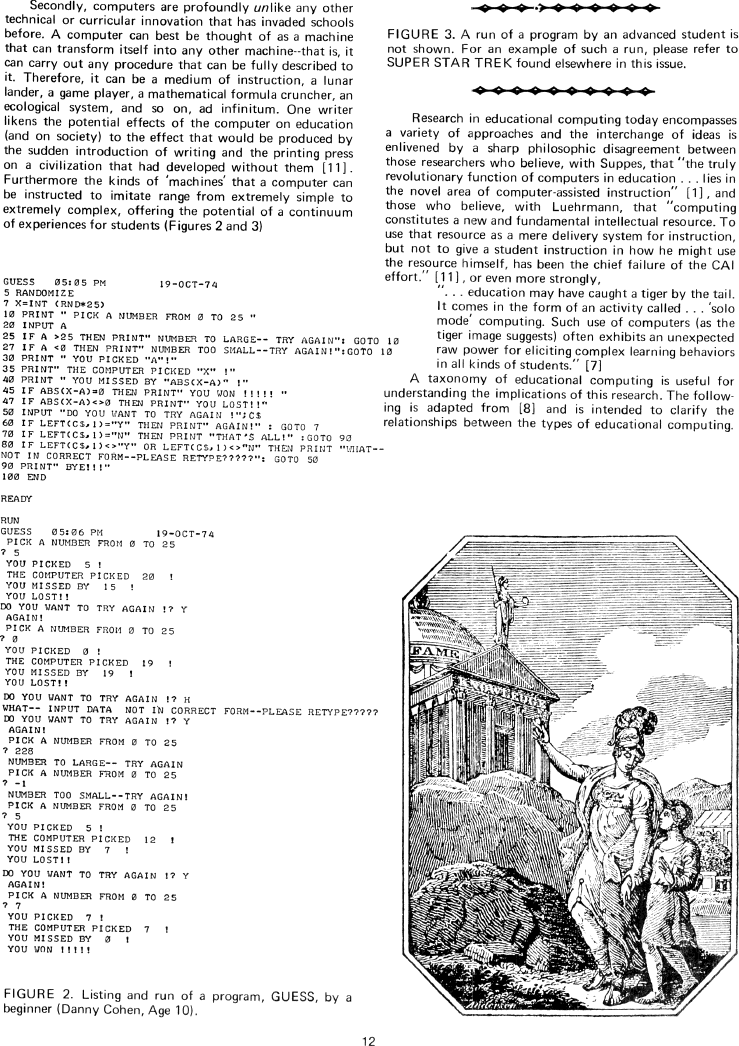The Best of Creative Computing Volume 1 (published 1976)
Recent Trends in Mathematics Curriculum Research

Secondly, computers are profoundly unlike any other
technical or curricular innovation that has invaded schools
before. A computer can best be thought of as a machine
that can transform itself into any other machine--that is, it
can carry out any procedure that can be fully described to
it. Therefore, it can be a medium of instruction, a lunar
lander, a game player, a mathematical formula cruncher, an
ecological system, and so on, ad infinitum. One writer
likens the potential effects of the computer on education
(and on society) to the effect that would be produced by
the sudden introduction of writing and the printing press
on a civilization that had developed without them [11].
Furthermore the kinds of 'machines' that a computer can
be instructed to imitate range from extremely simple to
extremely complex, offering the potential of a continuum
of experiences for students (Figures 2 and 3)
GUESS 05:05 PM 19'OCT-74
5 RANDOMIZE
7 X=INT (RN D*25)
10 PRINT " PICK A NUMBER FROM 0 T0 25 "
20 INPUT A
25 IF A >25 THEN PRINT" NUMBER TOO LARGE-- TRY AGAIN" GOTO 10
27 IF A <O THE PRINT NUMBER" TOO SMALL--TRY AGAIN!":GOTO 10
30 PRINT " YOU PICKED "A"!"
35 PRINT" THE COMPUTER PICKED "X" I"
4O PRINT " YOU MISSED HY "ABS(X-A)" !"
45 IF ABS(X-A)=O THEN PRINT" YOU WON !!!!! "
47 IF ABS(X~A)<>O THEN PRINT" YOU LOST!!"
5O INPUT "DO YOU WANT TO TRY AGAIN !";C$
60 IF LEFT{C$,1)="Y" THEN PRINT" AGAIN!" : GOTO 7
70 IF LEFT(C$,1)="N" THEN PRINT "THAT'S ALL!" :GOTO 90
80 IF LEFT(C$,1)<>"Y" OR LEFT(C$,1)<>"N" THEN PRINT "WHAT--
NOT IN CORRECT FORM--PLEASE RETYPE?????": GOTO 50
90 PRINT" EYE!!!"
10O END
READY
RUN
GUESS 05:06 PM 19-0CT-74
PICK A NUMBER FROM 0 TO 25
? 5
YOU PICKED 5 !
THE COMPUTER PICKED 20 !
YOU MISSED BY 15 !
YOU LOST!!
DO YOU WANT TO TRY AGAIN !? Y
AGAIN!
PICK A NUMBER FROM 0 TO 25
? 0
YOU PICKED 0 !
THE COMPUTER PICKED 19 !
YOU MISSED BY I9 !
YOU LOST!!
DO YOU WANT TO TRY IT AGAIN !? H
WHAT-- INPUT DATA NOT IN CORRECT FORM-PLEASE RETYPE?????
DO YOU WANT TO TRY AGAIN !? Y
AGAIN !
PICK A NUMBER FROM O TO 25
? 228
NUMBER T0 LARGE-- TRY AGAIN
PICK A NUMBER FROM 0 T0 25
? -l
NUMBER TOO LARGE--TRY AGAIN
PICK A NUMBER FROM 0 TO 25
? 5
YOU PICKED 5 !
THE COMPUTER PICKED 12 !
YOU MISSED BY 7 !
YOU LOST!!
DO YOU WANT TO TRY AGAIN !? Y
AGAIN!
PICK A NUMBER FROM O TO 25
? 7
YOU PICKED 7 !
THE COMPUTER PICKED 7 !
YOU MISSED BY 0 !
YOU WON !!!!!
FIGURE 2. Listing and run of a program, GUESS,by a beginner(Danny Cohen, Age
10).
12
FIGURE 3. A run of a program by an advanced student is
not shown. For an example of such a run, please refer to
SUPER STAR TREK found elsewhere in this issue.
Research in educational computing today encompasses
a variety of approaches and the interchange of ideas is
enlivened by a sharp philosophic disagreement between
those researchers who believe, with Suppes, that "the truly
revolutionary function of computers in education . . . lies in
the novel area of computer-assisted instruction" [1], and
those who believe, with Luehrmann, that "computing
constitutes a new and fundamental intellectual resource. To
use that resource as a mere delivery system for instruction,
but not to give a student instruction in how he might use
the resource himself, has been the chief failure of the CAI
effort." [11], or even more strongly,
"... education may have caught a tiger by the tail.
It comes in the form of an activity called ... 'solo
mode' computing. Such use of computers (as the
lu tiger image suggests) often exhibits an unexpected
raw power for eliciting complex learning behaviors
in all kinds of students." [7]
A taxonomy of educational computing is useful for
understanding the implications of this research. The follow-
ing is adapted from [8] and is intended to clarify the
relationships between the types of educational computing.


